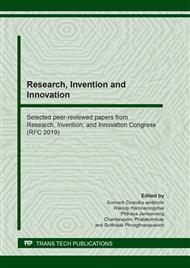[1]
F. Mazzolani, Aluminum Alloy Structures, second ed., Taylor and Francis, London, (1994).
Google Scholar
[2]
A.M. Kliauga, R.E. Bolmaro, M. Ferrante, The evolution of texture in an equal channel pressed aluminum AA1050, Mater. Sci. Eng. A. 623 (2015) 22-31.
DOI: 10.1016/j.msea.2014.10.073
Google Scholar
[3]
K.C. Sekhar, R. Narayanasamy, K. Velmanirajan, Experimental investigations on microstructure and formability of cryorolled AA 5052 sheets, Mater. Des. 53 (2014) 1064-1070.
DOI: 10.1016/j.matdes.2013.08.008
Google Scholar
[4]
R. Narayanasamy, R. Ravindran, K. Manonmani, J. Satheesh, A crystallographic texture perspective formability investigation of aluminium 5052 alloy sheets at various annealing temperatures, Mater. Des. 30 (2009) 1804-1817.
DOI: 10.1016/j.matdes.2008.09.011
Google Scholar
[5]
M. Jansson, L. Nilsson, K. Simonsson, On constitutive modeling of aluminum alloys for tube hydroforming applications, Int. J. Plast. 21 (2005) 1041-1058.
DOI: 10.1016/j.ijplas.2004.06.005
Google Scholar
[6]
S. Park, C.G. Lee, J. Kim, et al., J. Eng. Mater. Tech. 130 (2008) 1-10.
Google Scholar
[7]
V.K. Barnwal, R. Raghavan, A. Tewari, K. Narasimhan, S.K. Mishra, Effect of microstructure and texture on forming behaviour of AA-6061 aluminium alloy sheet, Mater. Sci. Eng. A. 679 (2017) 56-65.
DOI: 10.1016/j.msea.2016.10.027
Google Scholar
[8]
G. Centenoa, A.J. Martínez-Donaire, C. Vallellano, L.H. Martínez-Palmeth, D. Morales, C. Suntaxi, F.J. García-Lomas, Experimental Study on the Evaluation of Necking and Fracture Strains in Sheet Metal Forming Processes, Proc. Eng. 63 (2013) 650-658.
DOI: 10.1016/j.proeng.2013.08.204
Google Scholar
[9]
C. Vallellano, D. Morales, F.J. Garcia-Lomas, A study to predict failure in biaxially stretched sheets of aluminum alloy 2024-T3, Mater. Manu. Proc. 23 (2008) 303-310.
DOI: 10.1080/10426910801974804
Google Scholar
[10]
S. Basak, S.K. Panda, Necking and fracture limit analyses of different pre-strained sheet materials in polar effective plastic strain locus using Yld2000-2d yield model, J. Mater. Proc. Tech. 267 (2019) 289-307.
DOI: 10.1016/j.jmatprotec.2018.10.004
Google Scholar
[11]
N. Park, H. Huh, J.W. Yoon, Anisotropic fracture forming limit diagram considering non-directionality of the equi-biaxial fracture strain, Int. J. Sol. Struc. 151 (2018) 181-194.
DOI: 10.1016/j.ijsolstr.2018.01.009
Google Scholar
[12]
S. Panich, M. Liewald, V. Uthaisangsuk, Stress and strain based fracture forming limit curves for advanced high strength steel sheet, Int. J. Mater. Form. 11 (2017) 643-661.
DOI: 10.1007/s12289-017-1378-z
Google Scholar
[13]
K. Isik, M.B. Silva, A.E. Tekkaya, P.A.F. Martins, Formability limits by fracture in sheet metal forming, J. Mater. Proc. Tech. 214 (2014) 1557-1565.
DOI: 10.1016/j.jmatprotec.2014.02.026
Google Scholar
[14]
Y. Bao, T. Wierzbicki, On fracture locus in the equivalent strain and stress triaxiality space, Int. J. Mech. Sci. 46 (2004) 81-98.
DOI: 10.1016/j.ijmecsci.2004.02.006
Google Scholar
[15]
I. S. O. 12004-2, Metallic Materials-Sheet and Strip-Determination of Forming Limit Curves-Part 2: Determination of Forming Limit Curves in the Laboratory, International Organization for Standardization (2008), pp.5-8.
DOI: 10.3403/30150423u
Google Scholar
[16]
ASTM E2218-02, Standard Test Method for Determining Forming Limit Curves, ASTM Standards (2008), pp.1252-1266.
Google Scholar
[17]
S. Panich, F. Barlat, V. Uthaisangsuk, S. Suranuntchai, S. Jirathearanat, Experimental and theoretical formability analysis using strain and stress based forming limit diagram for advanced high strength steels, Mater. Des. 51 (2013) 756-766.
DOI: 10.1016/j.matdes.2013.04.080
Google Scholar
[18]
M.C. Butuc, J.J. Gracio, A.B. Da Rocha, An experimental and theoretical analysis on the application of stress-based forming limit criterion, Int. J. Mech. Sci. 48 (2006) 414-429.
DOI: 10.1016/j.ijmecsci.2005.11.007
Google Scholar
[19]
S. Panich, K. Chongbunwatana, M. Kamonrattanapisud, Formability prediction of advanced high-strength steel sheets by means of combined experimental and numerical approaches, Proc. Manu. 29 (2019) 528-535.
DOI: 10.1016/j.promfg.2019.02.171
Google Scholar
[20]
Y. Bao, T. Wierzbicki, A Comparative Study on Various Ductile Crack Formation Criteria, J. Eng. Mater. Tech. 126 (2004) 314-324.
DOI: 10.1115/1.1755244
Google Scholar
[21]
G.R. Johnson, W.H. Cook, Fracture characteristics of three metals subjected to various strains, strain rates, temperatures and pressures, Eng. Fract. Mech. 21 (1985) 31-48.
DOI: 10.1016/0013-7944(85)90052-9
Google Scholar
[22]
S. Basak, S.K. Panda, Failure strains of anisotropic thin sheet metals: Experimental evaluation and theoretical prediction, Int. J. Mech. Sci. 151 (2019) 356-374.
DOI: 10.1016/j.ijmecsci.2018.10.065
Google Scholar
[23]
R. Hill, A theory of the yielding and plastic flow of anisotropic metals, Proc. R. Soc. Lond, 193 (1948) 281-297.
Google Scholar
[24]
P. Kalawong, N. Seemuang, S. Panich, in: Proceeding of the 2nd International Conference on Engineering Innovation (ICEI), Bangkok Thailand (2018) 24-29.
DOI: 10.1109/icei18.2018.8448911
Google Scholar


